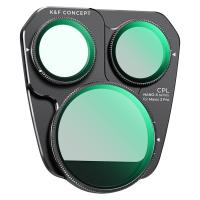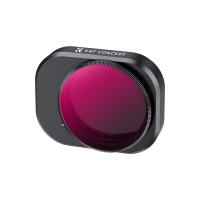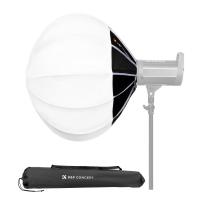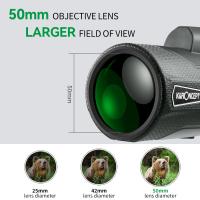What Is The Resolution Of Microscope ?
The resolution of a microscope refers to its ability to distinguish two separate points or objects as distinct and separate entities. It is typically measured as the minimum distance between two points that can still be resolved by the microscope. The resolution of a microscope is determined by several factors, including the numerical aperture of the lens system, the wavelength of light used, and the quality of the optics. Higher numerical aperture and shorter wavelengths of light generally result in better resolution. The resolution of a microscope can be improved by using techniques such as oil immersion, which increases the numerical aperture, or by using specialized microscopy techniques like confocal or super-resolution microscopy.
1、 Optical resolution
The resolution of a microscope refers to its ability to distinguish two closely spaced objects as separate entities. Optical resolution, specifically, is a measure of the smallest distance between two points that can be resolved by the microscope. It is determined by the numerical aperture (NA) of the objective lens and the wavelength of light used.
The resolution of a microscope is limited by the diffraction of light, which causes the light waves to spread out as they pass through the lens. This diffraction leads to a blurred image and limits the ability to resolve fine details. The theoretical limit of optical resolution, known as the Rayleigh criterion, states that two points can be resolved if the distance between them is greater than half the wavelength of light divided by the NA of the lens.
In recent years, there have been advancements in microscopy techniques that have pushed the limits of optical resolution. One such technique is super-resolution microscopy, which overcomes the diffraction limit by using fluorescent molecules that can be switched on and off. By precisely controlling the activation of these molecules, researchers can localize individual molecules with nanometer precision, allowing for the imaging of structures that were previously beyond the reach of traditional microscopy.
Super-resolution microscopy techniques, such as stimulated emission depletion (STED) microscopy and stochastic optical reconstruction microscopy (STORM), have revolutionized the field of microscopy by enabling the visualization of cellular structures and processes at unprecedented resolutions. These techniques have opened up new avenues of research and have provided valuable insights into the nanoscale organization of biological systems.
In conclusion, the resolution of a microscope, specifically optical resolution, is determined by the numerical aperture of the lens and the wavelength of light used. While there is a theoretical limit to optical resolution, advancements in super-resolution microscopy techniques have pushed the boundaries and allowed for imaging at nanometer scales. These techniques have greatly expanded our understanding of cellular structures and processes.

2、 Numerical aperture
The resolution of a microscope refers to its ability to distinguish two closely spaced objects as separate entities. It is a measure of the microscope's ability to provide clear and detailed images. The resolution of a microscope is determined by several factors, one of which is the numerical aperture (NA).
Numerical aperture is a measure of the light-gathering ability of a lens system. It is defined as the product of the refractive index of the medium between the specimen and the lens and the sine of the half-angle of the cone of light entering the lens. In simpler terms, it is a measure of how much light can enter the lens and contribute to the formation of an image.
A higher numerical aperture allows for a greater amount of light to enter the lens, resulting in improved resolution. This is because a larger numerical aperture allows for a smaller cone of light to be focused, which in turn allows for the detection of smaller details in the specimen.
In recent years, there have been advancements in microscope technology that have pushed the limits of resolution even further. Techniques such as super-resolution microscopy have allowed for the visualization of structures that were previously beyond the diffraction limit of light. These techniques utilize various methods, such as the use of fluorescent probes and clever data analysis algorithms, to overcome the diffraction limit and achieve resolutions on the nanometer scale.
Overall, the numerical aperture of a microscope plays a crucial role in determining its resolution. Higher numerical apertures result in improved resolution and the ability to visualize finer details in specimens. With the advent of super-resolution techniques, the resolution of microscopes has been pushed to new limits, enabling scientists to explore the intricate world of subcellular structures and processes.

3、 Depth of field
The resolution of a microscope refers to its ability to distinguish two closely spaced objects as separate entities. It is typically measured in terms of the smallest distance between two points that can still be resolved. The resolution of a microscope is determined by several factors, including the numerical aperture of the lens, the wavelength of light used, and the quality of the optics.
Depth of field, on the other hand, refers to the range of distances within which objects appear in focus. It is the distance between the nearest and farthest objects that can be simultaneously in acceptable focus. The depth of field is influenced by factors such as the aperture size, the magnification of the lens, and the distance between the lens and the object being observed.
The resolution and depth of field of a microscope are related but distinct concepts. While resolution determines the ability to distinguish fine details, depth of field determines the range of distances that can be in focus. A microscope with high resolution may have a limited depth of field, meaning that only a narrow range of distances will be in focus at any given time.
In recent years, advancements in microscopy techniques have led to improvements in both resolution and depth of field. Techniques such as confocal microscopy, two-photon microscopy, and super-resolution microscopy have pushed the limits of resolution, allowing scientists to observe structures at the nanoscale. Additionally, computational imaging techniques have been developed to extend the depth of field, enabling researchers to capture images with a larger range of distances in focus.
Overall, the resolution and depth of field of a microscope are important considerations in microscopy, and advancements in technology continue to push the boundaries of what is possible in terms of imaging capabilities.

4、 Contrast resolution
The resolution of a microscope refers to its ability to distinguish two closely spaced objects as separate entities. It is typically measured in terms of the smallest distance between two points that can still be resolved. However, when it comes to contrast resolution, the concept is slightly different.
Contrast resolution refers to the ability of a microscope to distinguish between objects with similar optical properties but different levels of contrast. It is particularly important when studying samples that have low inherent contrast, such as biological specimens. In these cases, the microscope needs to enhance the contrast between different structures or components within the sample to make them visible.
The contrast resolution of a microscope depends on several factors, including the quality of the optics, the type of illumination used, and the detection system. Advances in technology have led to the development of various techniques to improve contrast resolution. For example, phase contrast microscopy and differential interference contrast (DIC) microscopy use optical principles to enhance contrast in transparent samples. Fluorescence microscopy utilizes fluorescent dyes to label specific structures or molecules, thereby increasing contrast.
In recent years, there have been significant advancements in contrast resolution through the use of super-resolution microscopy techniques. These techniques, such as stimulated emission depletion (STED) microscopy and structured illumination microscopy (SIM), allow for the visualization of structures at a resolution beyond the diffraction limit of light. This has revolutionized the field of microscopy, enabling researchers to study cellular structures and processes in unprecedented detail.
In conclusion, the resolution of a microscope refers to its ability to distinguish closely spaced objects, while contrast resolution pertains to the ability to differentiate between objects with similar optical properties but different levels of contrast. Advances in technology have greatly improved contrast resolution, allowing for the visualization of structures and processes at a higher level of detail.






























There are no comments for this blog.